By Lawrence T. Locklear
The University of North Carolina at Pembroke grew out of a vision to improve the circumstances of the American Indians of Robeson County through education. As a result of a petition from American Indians of the county, state Representative Hamilton McMillan introduced legislation in 1887 that established Croatan Normal School, known today as UNC Pembroke.
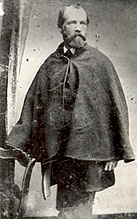 Hamilton McMillan (August 29, 1837 - February 27, 1916), the only child of William and Ann Peterson McNeill McMillan, was born in Roslin in Cumberland County, N.C. He was a Civil War veteran, educator, lawyer, politician, and amateur historian. He enlisted in Company F, North Carolina 1st Infantry Regiment on April 17, 1861 and mustered out on November 12, 1861, after the Battle of Bethel. He re-enlisted and remained on active duty until 1865 (North Carolina; “Col. Hamilton McMillan” 4). In 1873, after settling in Red Springs, N.C., McMillan married Elizabeth Gillespie Robeson (November 19, 1834 – January 23, 1906), daughter of John A. and Eliza S. Robeson and great-granddaughter of Col. Thomas Robeson, Robeson County’s namesake. Elizabeth was born in Ashwood in Bladen County, N.C.
Hamilton McMillan (August 29, 1837 - February 27, 1916), the only child of William and Ann Peterson McNeill McMillan, was born in Roslin in Cumberland County, N.C. He was a Civil War veteran, educator, lawyer, politician, and amateur historian. He enlisted in Company F, North Carolina 1st Infantry Regiment on April 17, 1861 and mustered out on November 12, 1861, after the Battle of Bethel. He re-enlisted and remained on active duty until 1865 (North Carolina; “Col. Hamilton McMillan” 4). In 1873, after settling in Red Springs, N.C., McMillan married Elizabeth Gillespie Robeson (November 19, 1834 – January 23, 1906), daughter of John A. and Eliza S. Robeson and great-granddaughter of Col. Thomas Robeson, Robeson County’s namesake. Elizabeth was born in Ashwood in Bladen County, N.C.
McMillan served Robeson County in the N.C. General Assembly (1885 - 1887) and became interested in the Indians of Robeson County. He was convinced that they were the descendants of John White’s Lost Colony and, in 1888, published a monograph titled “Sir Walter Raleigh’s Lost Colony” (Tyner 74). Earlier, in 1885, McMillan introduced legislation that gave the American Indians of Robeson County a legal identity and schools of their own. On March 7, 1887, the General Assembly enacted legislation, sponsored by McMillan, to create the Croatan Normal School, now UNCP (“Statue of Hamilton McMillan”).
When McMillan died in 1916, county residents expressed their grief in his passing. A Robesonian newspaper reporter described McMillan as “one of Robeson [C]ounty’s most honored men, and certainly there was no better type of Carolinian anywhere in the State. Colonel McMillan was scholar, sage and exemplar, and he was a powerful force in his community and county in his day of activity.” He “was the type of man who would leave his impress upon any community” (“Col. Hamilton McMillan” 4). American Indians also mourned McMillan’s passing. O.H. Lowrey wrote, “We, the true and tried are glad and do appreciate what has been done for us” (“Monument to H. McMillan” 3). The McMillans are buried in Alloway Cemeteryin Red Springs, N.C. across from Red Springs High School on N. Vance St/Watson Farm Rd.
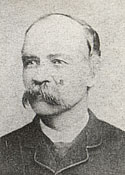 As a sign of the university’s appreciation, a statue of McMillan was unveiled in front of historic Old Main on March 5, 1987, during UNCP's 100th anniversary celebration.
As a sign of the university’s appreciation, a statue of McMillan was unveiled in front of historic Old Main on March 5, 1987, during UNCP's 100th anniversary celebration.
According to Pembroke State University: A Centennial History, “the seven-man Board of Trustees was charged with maintaining a school of ‘high grade for teachers of the Croatan race in North Carolina,’” as the Lumbee Indians were then known (Oxendine and Eliades 18). In addition, “The establishment and survival of the institution owed a great deal to determined leaders such as W.L. Moore, Preston Locklear, Hamilton McMillan and O.R. Sampson” (Oxendine and Eliades 24).
When the 1887 law was enacted, the General Assembly “appointed Preston Locklear, James Oxendine, James Dial, Sr., and Rev. W.L. Moore as trustees to carry out the act. It gave them authority to elect three other trustees, thus bringing the trustee body up to seven. JJ Oxendine, Isaac Brayboy and Olin Oxendine were immediately selected” (Cherokee Indian 7).
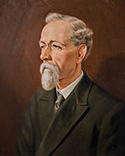 Rev. W.L. (William Luther) Moore (October 12, 1857 – December 22, 1930), a Waccamaw Siouan Indian and son of James and Caroline Spaulding Moore, was born in Columbus County, N.C. near Elkton. He began teaching school in Columbus County in 1874 and taught there for five years. According to a family oral history, Moore came to Robeson County as a traveling Bible salesman. During a visit to the county in 1879, Moore was introduced to James “Big Jim” Oxendine, a future UNCP trustee. “The true friendship never ceased from this time until” James’ death in 1896 (“Life of Rev. W.L. Moore” 3). That same year, Moore married Mary Catherine Oxendine (March 25, 1854 – January 7, 1928), daughter of Hugh and Eliza Chavis Oxendine and first cousin of trustees James “Big Jim” Oxendine and JJ Oxendine, and settled in the Prospect community north of Pembroke. She was the first American Indian female teacher in Robeson County. In 1881, Moore began four years of study, finishing the normal course (“Life of Rev. W.L. Moore” 3).
Rev. W.L. (William Luther) Moore (October 12, 1857 – December 22, 1930), a Waccamaw Siouan Indian and son of James and Caroline Spaulding Moore, was born in Columbus County, N.C. near Elkton. He began teaching school in Columbus County in 1874 and taught there for five years. According to a family oral history, Moore came to Robeson County as a traveling Bible salesman. During a visit to the county in 1879, Moore was introduced to James “Big Jim” Oxendine, a future UNCP trustee. “The true friendship never ceased from this time until” James’ death in 1896 (“Life of Rev. W.L. Moore” 3). That same year, Moore married Mary Catherine Oxendine (March 25, 1854 – January 7, 1928), daughter of Hugh and Eliza Chavis Oxendine and first cousin of trustees James “Big Jim” Oxendine and JJ Oxendine, and settled in the Prospect community north of Pembroke. She was the first American Indian female teacher in Robeson County. In 1881, Moore began four years of study, finishing the normal course (“Life of Rev. W.L. Moore” 3).
At 6’4” tall, Moore, literally and figuratively, cast a shadow of influence over the American Indian community and the institution that still resonates today. He was an ordained Methodist minister, teacher, administrator and farmer. He “presided over several annual conferences” and “served throughout Marlboro and Chesterfield Counties in S.C. and Richmond, Scotland and Robeson in N.C." (“Life of Rev. W.L. Moore” 3).
Moore and other American Indian leaders urged McMillan to introduce the bill to establish Croatan Normal School. Moore was also a co-signer of the petition submitted to McMillan in 1887. Moore was the first teacher and principal of Croatan Normal School (1887 – 1890) and served on the Board of Trustees. He donated $200 of his own money toward the construction of the only building on the original site of the institution in the Pates community, one and half miles west of Pembroke (1887 – 1909). Moore’s students included Dr. Governor Worth Locklear (the first Lumbee doctor), Rev. O.R. Sampson and Anderson N. Locklear (“Life of Rev. W.L. Moore” 3). According to the university’s centennial history, “W.L. Moore is … known in the history of this institution as ‘Founder, Erector, Teacher’” (Oxendine and Eliades 19).
At the time of his death in 1931, Moore was described as “a man who everyone concedes has been without an equal for the uplift of humanity, the education of a devastated people and the pioneer church worker of the Indian race of the state.” In addition, “It was conceded by all that knew him that his magnanimity was unexcelled…. He was wide awake to the people’s needs, often giving both small and large gifts, as he thought it best for the advancement of humanity, irrespective of their financial status” (“Life of Rev. W.L. Moore” 3).
Moore is buried at his residence in the Prospect community, northwest of Pembroke, on W.L. Moore Road. His wife Mary Catherine is buried at Oxendine Cemetery across from Oak Grove Baptist Church in the Union Chapel Community, northeast of Pembroke, on Oak Grove Church Road.
Moore Hall, located adjacent to historic Old Main, is named in honor of Moore. Built in 1951, the building is home to the Department of Music.
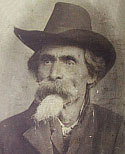 Preston Locklear (March 16, 1839 – January 21, 1916), a Lumbee Indian, was the son of Zack and Matilda Bullard Locklear. He married Emmaline Lowry (1845 – August 28, 1920), daughter of Rev. Peter Patrick (P.P.) and Catherine Strickland Lowry, and resided in the Prospect community. Locklear was a farmer and logger and, like the other forefathers of the institution, an influential and respected member of the community. Prior to serving on the Croatan Normal Board of Trustees, Locklear was a trustee for a local subscription school. He was one of the first to make the move for separate American Indian schools in Robeson County. Locklear was an honorary member of the Confederate Order of the Red Men and the father of the first American Indian physician in Robeson County, Dr. Governor Worth Locklear (“Death of Preston Locklear” 1). Locklear and his wife are buried in Preston Cemetery in the Prospect community on Preston Road.
Preston Locklear (March 16, 1839 – January 21, 1916), a Lumbee Indian, was the son of Zack and Matilda Bullard Locklear. He married Emmaline Lowry (1845 – August 28, 1920), daughter of Rev. Peter Patrick (P.P.) and Catherine Strickland Lowry, and resided in the Prospect community. Locklear was a farmer and logger and, like the other forefathers of the institution, an influential and respected member of the community. Prior to serving on the Croatan Normal Board of Trustees, Locklear was a trustee for a local subscription school. He was one of the first to make the move for separate American Indian schools in Robeson County. Locklear was an honorary member of the Confederate Order of the Red Men and the father of the first American Indian physician in Robeson County, Dr. Governor Worth Locklear (“Death of Preston Locklear” 1). Locklear and his wife are buried in Preston Cemetery in the Prospect community on Preston Road.
James E. Dial Sr. (1855 – November 8, 1933), a Lumbee Indian, was the son of George and Mary Lowrie Dial. Dial was from an area near Harpers Ferry Baptist Church, south of Pembroke. He married Elizabeth “Bettie” Locklear (1866 - December 22, 1923), daughter of Randal and Ruth Quick Locklear, on February 15, 1877 in Robeson County. They settled in the Saddletree community, northwest of Lumberton, near Bettie’s parents. Dial was a “progressive farmer,” who served on the Board of Trustees for 35 years (“High Tribute” 7). He was also a charter member of Mt. Olive Baptist Church in the Saddletree community (“Memorial Services” 4).
At Dial’s funeral in 1933, J.E. Sawyer, superintendent of Cherokee Normal School, described Dial “as a man of public affairs all his life – one who had given his time and thought towards enhancing the educational privileges of the Indian people” (“High Tribute” 7). Clifton Oxendine, a prominent figure in the history of the institution and the Lumbee community, described Dial in the following way:
“But he was a bigger man than just merely a farmer. He found keen interest in all matters affecting the welfare and elevation of his race. He served his community well, but never by those subterfuges and evasion which are the characteristics of a poor citizen. It was soon learned by all that knew him that he cared more for his reputation as an honest man than he did for the mere praise of mankind. There will forever remain with those who knew him at home, on the road, or in business transactions, the image of him in his unfailing determinism and integrity and his willingness to work hard for the things which he wanted and needed. The memory of Mr. Dial’s untiring efforts and zeal for improved educational conditions for the Indian race will test our fidelity to his example; recollections of the public-mindedness of him in behalf of mankind will spur us on to a nobler human service.”
We should “pledge ourselves somehow to ‘carry on’ what he so gloriously began in the way of being more progressive, in establishing better schools, and in other worthy lines of endeavor” (“High Tribute” 7).
Dial and his wife are buried in Dial Cemetery in Lumberton, N.C. in front of Piney Grove Elementary School on Piney Grove Road. Piney Grove School is also known as the James Dial School.
Isaac Brayboy (January 21, 1836 – February 3, 1919), a Lumbee Indian and the son of Absalom and Francis “Frankey” Brayboy, was a resident of the Bear Swamp community, north of Pembroke between the St. Annah and Union Chapel communities. He first married Aggie Jane Chavis (1843 – abt. 1876), daughter of Hughie and Clarissa Lowry Chavis who died at a young age. His second wife was Rhoda Deese (1860 – July 29, 1940), daughter of Silas and Julia Lowery Deese. Brayboy, a farmer and turpentine laborer, was an active supporter of Indian education and the Methodist church. After the southern Methodist Episcopal Church “separated out” non-white members in 1870, Union Chapel Methodist was placed under the direction of Isaac Brayboy and Ismael Chavis (Smith 13). In 1906, Brayboy was chosen as an alternate delegate to the Robeson County Democratic Convention for the Burnt Swamp district (“Township Primaries” 1). In 1912, Brayboy gave the prayer at a box supper fundraiser at Union Grove Methodist Episcopal Church in the Union Chapel community (“Successful Box Supper” 6). According to a family oral tradition, lumber used in the construction of historic Old Main was supplied by his grandson Tecumseh’s sawmill located north of Pembroke, near Buie (Braveboy-Locklear). Brayboy is buried at St. Annah Free Will Baptist Church, north of Pembroke.
James “Big Jim” Oxendine (1821 – December 16, 1896), a Lumbee Indian, had kinship ties to other trustees. The son of James Sr. and Elizabeth Oxendine, he was brother to J.J. Oxendine and father to Olin Oxendine. Oxendine and W.L. Moore’s wife were first cousins. Oxendine married Eliza Lowry (June 14, 1819 – November 17, 1889), daughter of Daniel and Elizabeth “Betsy” Locklear Lowry, and settled in the Pates community.
Oxendine was a prosperous merchant and farmer. During Reconstruction, Oxendine was the first American Indian elected county commissioner in Robeson County. In 1868, as described by W. McKee Evans wrote in To Die Game, “... there were also some brown Indian faces that had never been seen on the county court of the old regime. James Oxendine, known as "Big Jim," a prosperous Indian merchant and farmer, had been elected one of the county commissioners” (Evans 90). Oxendine was a lifelong friend with W.L. Moore. He is buried in Oxendine Cemetery at Sampson Junction (NC HWY 711 and Deep Branch Road), south of Pembroke, while Eliza is buried with her siblings at St. Annah Free Will Baptist Church, north of Pembroke.
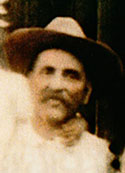 Olin Oxendine (January 7, 1853 – July 6, 1932), a Lumbee Indian, was the son of James “Big Jim” and Eliza Lowry Oxendine. Olin first married Mollie Lowrie (1859 - ?) on January 25, 1877 in Robeson County. Around 1895, Olin married his second wife, Flora Lowry (March 28, 1865 – December 17, 1944), daughter of John Locklear and Vicilla Lowry. Like the other trustees, Oxendine was a farmer. They lived in the Bear Swamp community near Pembroke. Olin and Flora are buried in Oxendine Cemetery at Sampson Junction (NC HWY 711 and Deep Branch Road), south of Pembroke.
Olin Oxendine (January 7, 1853 – July 6, 1932), a Lumbee Indian, was the son of James “Big Jim” and Eliza Lowry Oxendine. Olin first married Mollie Lowrie (1859 - ?) on January 25, 1877 in Robeson County. Around 1895, Olin married his second wife, Flora Lowry (March 28, 1865 – December 17, 1944), daughter of John Locklear and Vicilla Lowry. Like the other trustees, Oxendine was a farmer. They lived in the Bear Swamp community near Pembroke. Olin and Flora are buried in Oxendine Cemetery at Sampson Junction (NC HWY 711 and Deep Branch Road), south of Pembroke.
JJ (John J.) Oxendine (1826 – November 28, 1903), a Lumbee Indian, was the son of James Sr. and Elizabeth Oxendine and brother to James “Big Jim” Oxendine. JJ married Mary Jane (1835 – May 12, 1909). A farmer, he and his wife lived in Bear Swamp in the present-day Red Banks community southwest of Pembroke. JJ and Mary Jane are buried at Sandcutt Cemetery, southwest of Pembroke, on Oxendine Road.
The legacy of the McMillan, Moore and the first Board of Trustees lives on today in the students, faculty, staff and alumni of this great university as they work each day to carry forward the vision of the university’s founders.
Works Cited
Braveboy-Locklear, Barbara. “Re: Isaac Brayboy.” Message to the author. March 15, 2010. E-mail.
Cherokee Indian Normal School Bulletin and Outlines Course of Study. The University of North Carolina at Pembroke. n.d. Web. March 15, 2010. PDF
“Col. Hamilton McMillan.” Robesonian [Lumberton, NC] March 2, 1916. 4. Print.
“Death of Preston Locklear.” Robesonian [Lumberton, NC] Jan. 24, 1916. 1. Print.
Evans, William McKee. To Die Game: The Story of the Lowry Band, Indian Guerrillas of Reconstruction. Baton Rouge: Louisiana State University Press, 1971. Print.
“High Tribute Paid To Mr. J.E. Dial.” Robesonian [Lumberton, NC] Nov. 16, 1933. 7. Print.
“Life of Rev. W.L. Moore, Prominent Indian and Leader of His Race.” Robesonian [Lumberton, NC] Feb. 9, 1931. 3. Print.
“Memorial Services In Honor Of Mr. J.E. Dial.” Robesonian [Lumberton, NC] Jan. 1, 1934. 4. Print.
“Monument to H. McMillan.” Robesonian [Lumberton, NC] March 20, 1916. 3. Print.
North Carolina. Division of Archives and History. North Carolina Troops 1861-1865 A Roster. 14 vols. Raleigh: University Graphics, 1993.
Oxendine, Linda E. and David K. Eliades. Pembroke State University: A Centennial History. Columbus, GA: Brentwood University Press, 1986. Print.
Smith, Joseph Michael, and Lula Jane Smith. The Lumbee Methodists: Getting to Know Them, A Folk History. Raleigh, NC: Commission of Archives and History of the North Carolina Methodist Conference, 1990.
“Statue of Hamilton McMillan.” The University of North Carolina at Pembroke. March 15, 2010. Web. March 15, 2010.
“Successful Box Supper at Union Grove.” Robesonian [Lumberton, NC] March 11, 1912. 6. Print.
“Township Primaries.” Robesonian [Lumberton, NC] Sep. 3, 1906. 1. Print.
Tyner, K. Blake. Robeson County: Images of America. Charleston, SC: Arcadia, 2003. Print.
